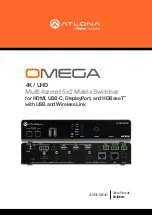
24
HD-SDI Cabling Advice
Start with good cabling. BNC coax cables and connectors are not all made to the same standard. From the
thickness and grade of the centre conductor to the type of dielectric, all these factors contribute to
impedance, attenuation and Return Loss (RL). Serial Digital Video coax like Belden 1694A or Canare L5CFB
are good examples of broadcast quality SDI cable.
A 75 Ohm (Ω) impedance must be maintained throughout the SE-2000 SDI signal or cable path, including
BNC connectors etc.
Return Loss is the portion of the transmitted SDI signal that is not admitted to the receiver and is then
reflected back along the cable toward the transmitter (DAC-9). Reflections in the transmission path will cause
attenuation as well as distortion of the SDI signal received. The signal is attenuated because part of it is
reflected back and does not make it to the receiver (SE-2000 for example); it is also distorted because the
reflected signal mixes with the original signal causing it to distort as well as adding to the noise floor.
Care must also be taken with cable length, as it will affect the error rate in the SDI signal. Cable lengths
beyond acceptable limits will see error rates reach a tipping point and this will bring about a total loss of
picture also known as the
Cliff Effect
. Always check with your supplier for cabling advice on the maximum
distance for a particular signal and data rate, in this case an SDI signal that complies with the SMPTE 292M
standard at 1.5 Gbps. Datavideo Taiwan have determined that single BNC SDI cable (5CFB) runs of up to
100m should be possible with this unit before the signal would need to be re-clocked or repeated.
Here is a basic list of other things to avoid
• Do not step on or rest equipment on the cables.
• Do not roll dollies or trolleys over the cables.
• Do not put kinks or sharp bends in the cables.
• Do not exceed the minimum bend radius of the cable.
The general rule for an acceptable bend radius is 10 times the diameter of the cable.
• Cable pulls should be done carefully – do not jerk or stretch the cable(s).
Do not exceed the cable’s maximum pulling tension.
(call the cable supplier / manufacturer for this information.)
• Do not pull cable ties too tight on cable looms.
If you cannot move any cable inside a loom tie, the tie is too tight.
Put an extra piece of cable in when tightening loom ties - then remove it afterwards to create the space.
• Do not put cable management fixings at standard distances apart.
This can lead to deformity at a given wavelength, which can increase RL.
Place your loom cable ties at random distances for the same reason.
Summary of Contents for SE-2000
Page 1: ...Digital Video Switcher SE 2000 INSTRUCTION MANUAL www datavideo tek com ...
Page 11: ......
Page 13: ......
Page 20: ...20 Example SE 2000 Set Ups ...
Page 22: ......
Page 39: ......
















































